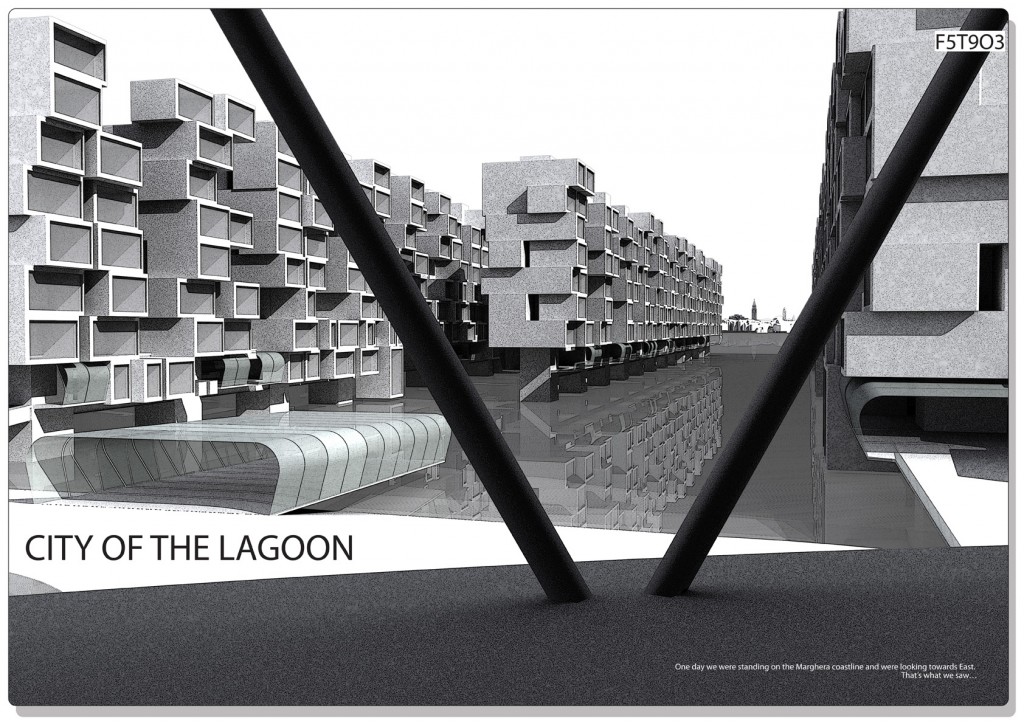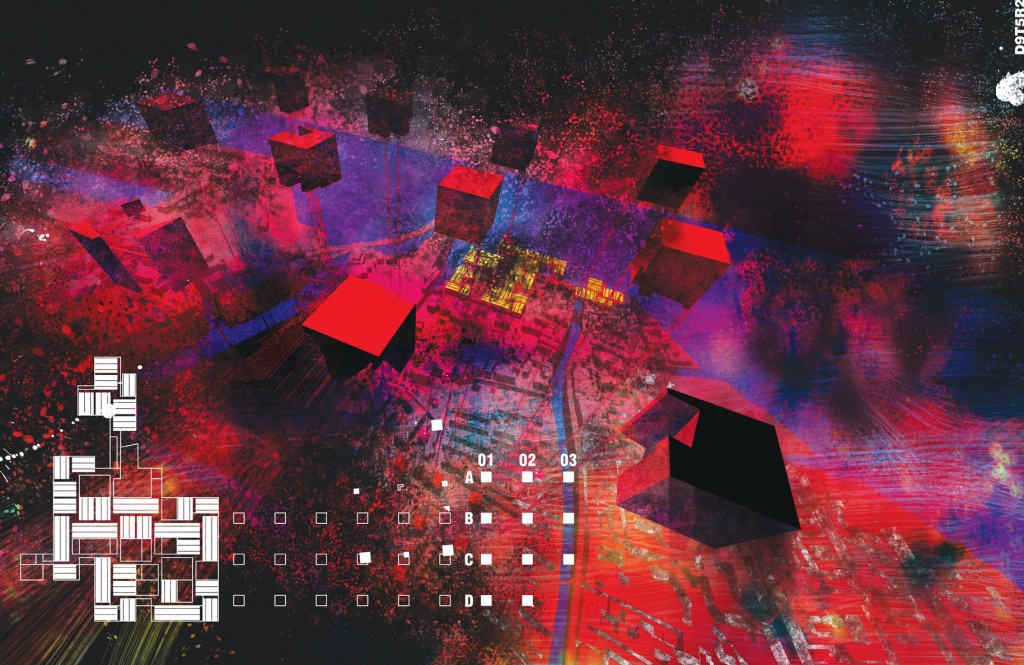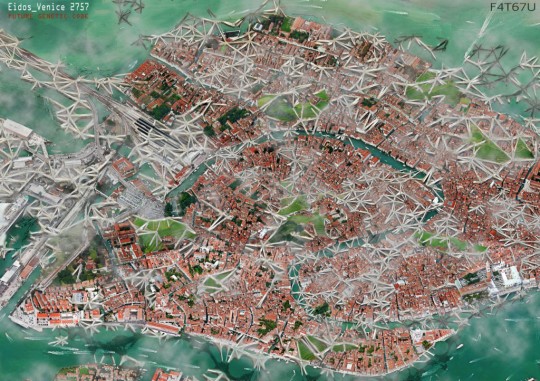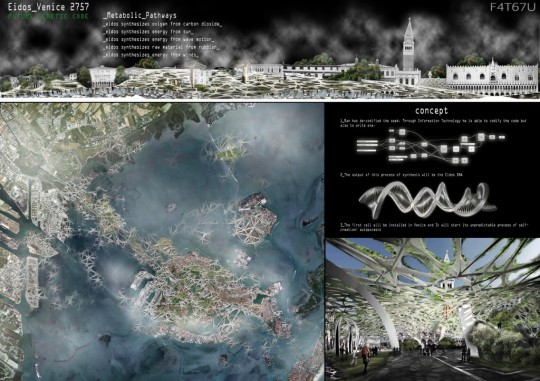Info:
Title: Eidos - Code: F4T67UContest: Venice / 2011
By: D. Mariani / P. Scarpa
Views: 2610 Likes: 0
Votes:
BJARKE INGELS6 NERI OXMAN9 ELENA MANFERDINI8 MARIA LUDOVICA TRAMONTIN3 BOSTJAN VUGA15.4
Eidos
Eidos. Venice 2757 Introduction A city where time has stopped, while the rest of the planet keeps on producing chaos; a city that oppresses its inhabitants with its hyper-identity and its business; a city which is absolutely inadequate in sustaining the lives of its citizens. This is Venice. And this could be considered its fate. Venice can be defined as a sort of huge “souvenir”, a “cultural-playground”, where reality is de-realized and every pathway, every image, every instant loses its meaning because of its repetitive dramatisation. This process is based on actions that develop through specific time and through such devices, as the digital camera, which typically belong to tourists. The time of the process of de-realization is “afterwards”, back home, when every picture will be shown to friends and families, bestowing a meaning “a posteriori” upon their “passage to Venice”. Thus, Venice has undergone a transformation into a long-performed product created by tourism. Venice has become a fiction. Everybody knows the image of Venice but what is the most meaningful one, the one that really represents it? Isn’t the repetitive and obsessive representation depriving the space of its meaning?
Venice is an immense tourist attraction, and it hardly keeps the semblance of an urban area; nowadays it can be barely defined as a “city”. It is more like an embalmed corpse in a transparent glass coffin made so it could be seen and admired from all sides. Every stone, every pillar, every bridge, every space is an element of the scenery functional to the “show”.
The crystal has repetitive, static, rigid and immutable spatial configuration; during its process of creation, it becomes real by replicating its original structure endlessly. The identity and the history of Venice are dramatised for the use of the tourist; therefore, it condemns it to a crystallization of itself, together with its relations and its fabric of society. Venice is a crystal that expands in the collective imagination. The city, this way, cannot change or regenerate or expand: it can only be an attraction, overcrowded with tourists and less than ever experienced by its inhabitants.
In a dystopic future, a “mega-structure” is blending with what can now be defined the untouchable ” layer of the non-living”, in order to restore meaning to the spaces and citizenship to the community.
The mega-structure is a dwelling, a route, a public space, a social space, a flow, a relation, and vital nourishment for a city that is regenerating.
Eidos
Eidos is the shaping of an autopoietic organism, which generates through morphogenesis from a bio- engineering code. The code is an algorithm that is, at the same time, virtual, since it is calculated by computers, conceptual because man created it, and genetic because it constitutes Eidos DNA.
The output of this process of synthesis will be the first Eidos cell, which will be installed in Venice and it will start its unpredictable process of self-creation: autopoiesis, between vegetable and architectural.
The algorithm allows Eidos to interact with the external environment variable, such as the reality of Venice, and during its autonomous growing process, it lets Eidos change through a continuous flow of spatial and temporal information.
There is no control at all on the formal results that this process will produce in the end; notwithstanding the countless simulations performed on the computer, it has not been possible to summarise the whole complexity of the real in bit, 0 and 1. Some indefiniteness still remains.
Nevertheless, the algorithm we have written and the functions that Eidos will perform are a certainty.
Eidos will solve the problems men have not been able to solve. Eidos can determine metabolic pathways.
It can synthesize oxygen from carbon dioxide and then release it in the atmosphere.
It allows the synthesis of energy, useful for the city, from photons of sunlight.
It allows the synthesis of raw material from waste material.
It converts the fluid motions of the lagoon and the winds that blow into energy.
Eidos can recombine the different spatial meanings of the city, inevitably, just because it simply exists.
In the XV century, Pico della Mirandola broadened the horizons of the modern world, with his oration on the dignity of man. According to Pico, God creates men free from all kind of archetypes, from any essence and he lets men self-determinate and establish in an autonomous way the limits of their action. It gave life to a human way of being which is neither definite nor limited, because God has delivered destiny in the hands of men. Indefiniteness and men blend into one.
Modernity can develop from the starting point of this new awareness: what is human is a project of men, and modernity is the time of continuous going beyond.
The idea of overtaking modernity seems a paradox to our mind. Just like overtaking the phase of changes with a change.
Man wanders in the noosphere through research, developing techniques and deepening his knowledge. Man can advance his scientific knowledge so that he himself can create indefiniteness. Man turns from object of uncertainty to creator of uncertainty. He has de-codified the seed. Through Information Technology he is able to codify the code but also to write one. Eidos.
The task is not over; indefiniteness remains, it even increases.
We have shifted from continuous overtaking, from the constant attempt of modernity to reduce and analyse indefiniteness, in order to solve it, to the phase of the constant increasing of indefiniteness.
Overtaking has been finally overtaken.
Eidos is this jump ahead.
Info:
Title: Eidos
Time: 7 giugno 2011
Category: Venice
Views: 2610 Likes: 0
Tags: Adriatic Sea , Current sea level rise , God , Philosophy , Rome , Scripps Institution of Oceanography , Technology , Venice








